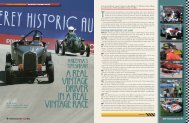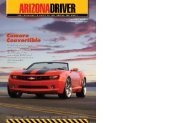Corvette's 50th Anniversary Corvette's 50th Anniversary
Corvette's 50th Anniversary Corvette's 50th Anniversary
Corvette's 50th Anniversary Corvette's 50th Anniversary
Create successful ePaper yourself
Turn your PDF publications into a flip-book with our unique Google optimized e-Paper software.
The latest model, the 2003 <strong>50th</strong> <strong>Anniversary</strong> Corvette, meets up with its ancestor, the original 1953 roadster.<br />
headlamp covers and the sleek styling added up to an elegant<br />
package. It retained this basic design for several years and then<br />
underwent a redesign that featured quad headlamps with<br />
chrome bezels, a louvered hood and wraparound bumpers.<br />
The Sixties<br />
By the time the 1960 model debuted, the Corvette was almost<br />
entirely chromeless. During this decade, GM’s stylists tweaked<br />
the design nearly every year, giving just about every model year<br />
a fresh, distinctive look. Model year 1960 brought standard<br />
blackwall tires and the end of the shark’s tooth grille. A blackedout<br />
chrome mesh screen replaced it, and then, in 1963, thin,<br />
horizontal grille bars graced the front end that remained until<br />
’66. A ducktail rear end offered more trunk space.<br />
Engineers designed the first CERV-I experimental model in<br />
1962 that pushed the boundaries of Corvette design. Two-toned<br />
paint exited by 1962, and the trademark hidden headlamps<br />
30 • November/December 2003 • ARIZONADRIVER<br />
appeared in 1963. Model year 1962 also brought the Bill Mitchell<br />
Mako Shark I, which led to the controversial split rear-window ’63<br />
Sting Ray coupe. At the time, critics derided the split window for<br />
its limited visibility, but today, these models are among the most<br />
highly coveted, collectible Corvettes. The ’63 model marked the<br />
first time the car came as a closed coupe, and it featured a sleek,<br />
aero look and the introduction of hidden retractable headlights.<br />
The Grand Sport Corvette racecar debuted in 1963.<br />
In 1964 the split window disappeared and was replaced by a<br />
new one-piece window. Designers also removed the faux air<br />
intakes in the hoods and the functional air-exhaust vents on the<br />
pillar. In 1965 Chevy showed the Mako Shark II. Built on a Sting<br />
Ray chassis, with styling similar to Mako I, the II had a lower<br />
stout and shorter tail. It proved to be one of most famous<br />
Corvette showcars and the Sting Ray forerunner.<br />
The following year, an eggcrate insert replaced the horizontal<br />
grille bars, and Corvettes gained ribbed rocker moldings and a side<br />
mounted exhaust system option and, in 1967,<br />
the last of the Sting Rays rolled off the line.<br />
GM restyled the ’68 model, called the Shark,<br />
with a long, low profile, blunt design, bulging<br />
fenders, a tunneled roofline, and added the<br />
Mako Shark II’s close-to-the ground snout.<br />
Larger fender louvers improved cooling, and<br />
removable roof panels and rear glass added<br />
convenience. The car kept the quad taillights<br />
and hidden quad headlamps. In 1969 Chevrolet<br />
resurrected the Stingray name, now as one<br />
word. The Mulsanne show car appeared, with<br />
high, side view mirrors and exposed headlights.<br />
It paced the Can-Am race series.<br />
The Seventies<br />
In 1970, Corvette’s chrome eggcrate grille<br />
returned and stainless steel sill moldings<br />
debuted. A special Aero Coupe model combined<br />
the ’69 Corvette design with a crosshatched<br />
grille and vent, one-piece roof, side exhaust and<br />
higher windshield. The XP-882 prototype<br />
appeared at 1970 New York Auto Show with a<br />
low, square front end, hidden headlamps,<br />
louvered boattail at the back, bulging rear<br />
fenders and a fastback.<br />
Model year 1972 marked the final year for the<br />
front and rear chrome bumpers and removable<br />
rear windows. A mid-engined silver XP-895 prototype debuted,<br />
serving as a study in aluminum construction.The following year,<br />
1973, Corvette underwent its first big redesign since 1968. A new<br />
bumper, created to meet federally mandated five-mph bumpers,<br />
added two inches to the length. The long, sleek V-shape front end,<br />
with a urethane plastic nose that bounced back into shape, neatly<br />
camouflaged the utilitarian nature of the change. Also in ’73, an<br />
XP-898 prototype gave clues to the design of the C4 Corvette that<br />
was to debut 10 years later.<br />
In 1974 Corvette added the five-mph rear bumper, a Kammstyle<br />
tail, new front and rear ends and new trim and scoops. The<br />
latter part of the ’70s brought few exterior changes to the<br />
Corvette, save an exterior luggage rack on the convertible in ’75<br />
(the final year for a convertible until its return in 1986), a new<br />
fastback roof in ’78, and the end of the Stingray name in ’77.<br />
Corvette celebrated its 25th birthday with an Indy pace car and<br />
Silver <strong>Anniversary</strong> edition.<br />
The fiberglass floorpan of the original ’53 set the stage for a materials revolution.<br />
The Eighties<br />
In 1980, new front and rear spoilers improved aerodynamics and<br />
offered a more modern appearance. Most of the design changes<br />
lowered the mass of the car by 250 lbs.<br />
GM produced exactly zero 1983 model year Corvettes, but<br />
mid-year the first all-new Corvette in 15 years debuted to much<br />
acclaim. This modern interpretation featured a lift-up rear<br />
window, one-piece lift-off top and a forward-opening clamshell<br />
hood. The ’84 model grew two-inches in width, but was smaller<br />
everywhere else to improve handling. Also new was a birdcage<br />
uniframe construction with fully welded, galvanized steel.<br />
In 1986, Corvette resurrected the convertible and showed a<br />
mid-engined, low-to-the-ground Corvette Indy concept car with<br />
scissor-hinged doors, glass-in cockpit, high back and a bubble<br />
canopy that flowed into a rounded nose.<br />
1963 1968 1975 1979<br />
KEEP RIGHT >><br />
ARIZONADRIVER • November/December 2003 • 31





